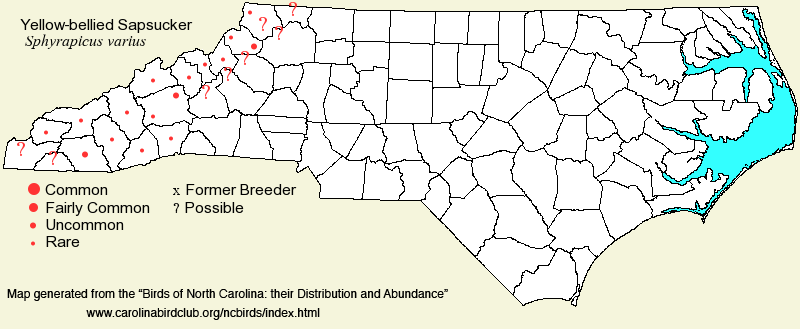 |  |
|
Yellow-bellied Sapsucker - Sphyrapicus varius PICIDAE Members: | Search Common: Search Scientific: |
|
|
|||||||
| General Comments | The Yellow-bellied Sapsucker is the only true migratory woodpecker species in eastern North America. It both breeds and winters in the state, though over most of North Carolina it is known as a winter bird, because it nests only at middle and higher elevations in the mountains. In summer, it breeds primarily where there are numerous dead trees, such as in recently burned or diseased areas, but it is mysteriously local in its distribution, being practically absent in some mountain counties. However, it is always associated in summer with mature and open stands of hardwoods, and never in dense forests. Away from the breeding grounds, it has a very wide habitat selection, though typically near or in mature hardwoods. It is found in both uplands and lowlands, mixed pine-hardwood stands, and often in residential areas. At this season, it usually joins mixed species flocks with chickadees, titmice, kinglets, nuthatches, and other songbirds. Sapsuckers are a bit more retiring or silent than most other woodpeckers in winter and can be easily overlooked. | ||||||
| Breeding Status | Breeder | ||||||
| NC BRC List | Definitive | ||||||
| State Status | SR | ||||||
| U.S. Status | |||||||
| State Rank | S2B,S5N | ||||||
| Global Rank | G5 | ||||||
| Coastal Plain | Winter resident. Fairly common to occasionally or locally common throughout; less common on barrier islands. Normally present from late Sep to late Apr, becoming numerous by mid-Oct; dates ranging from 13 Sep to 8 May. Peak counts: ? | ||||||
| Piedmont | Winter resident. Fairly common essentially throughout. Mainly from late Sep to mid-Apr; dates ranging from 9 Sep to 15 May. Peak counts: ? | ||||||
| Mountains | Breeder and winter resident, with strong migratory movements. Rare to uncommon and quite local as a breeder, though seemingly increasing in the past few years; generally from 3,500 feet to about 5,000 feet. Areas of frequent occurrence are the Cone Park/Price Park area near Blowing Rock, Linville, northeastern Buncombe, Nantahala Mountains (western Macon), and the Heintooga Ridge area of Great Smoky Mountains NP. At other seasons, fairly common in winter and migration at lower elevations (below 3,000 feet), and rare to uncommon at higher elevations. Migrants arrive around late Sep and depart by late Apr. Peak counts: 11, Wayah Bald area (Macon), 1 Jul 1975. | ||||||
| Finding Tips |
In the breeding season, check any of the areas listed above, for the mountains. From Oct through Mar, one to several can normally be seen in a given day over most of the state; carefully check chickadee/titmouse flocks. *** (winter) | ||||||
| Attribution | LeGrand[2024-02-10], LeGrand[2023-03-22], LeGrand[2021-08-04] | ||||||
| NC Map Map depicts all counties with a report (transient or resident) for the species. | Click on county for list of all known species. |
| NC Breeding Season Map Map depicts assumed breeding season abundance for the species. |  |